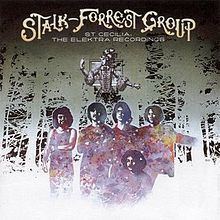Released 23 April 2001 Release date 23 April 2001 | ||
 | ||
Recorded Elektra Sound Recorders, New York City and Los Angeles, February–May 1970 Producer Dennis Murphy, Peter Seigel, Jay Lee Blue Öyster Cult albums Career of Evil: The Metal Ye, Curse of the Hidden Mirror, Bad Channels, The Essential Blue Öyst, Cult Classic | ||
Stalk forrest group st cecilia the elektra recordings 1970 full album
St. Cecilia: The Elektra Recordings is a compilation album by the American rock band Stalk-Forrest Group, which would later become the successful hard rock band Blue Öyster Cult. The tracks were recorded in 1969 and early 1970, but not officially released until 2001 (aside from a promo-only single of the song "What is Quicksand?" released in 1969 or 1970). The album compiles all the recorded output by the group that was recorded for Elektra Records during their short tenure with the label.
Contents
- Stalk forrest group st cecilia the elektra recordings 1970 full album
- Overview
- Song details
- Track listing
- Personnel
- Songs
- References
Overview
The band (originally known as 'Soft White Underbelly') had recorded demos for Elektra Records in 1969 with original vocalist Les Braunstein. Elektra signed the group based on the demos with a $100,000 advance. When vocalist Braunstein left the band, the group re-recorded the songs in New York with new vocalist, former roadie Eric Bloom. The 10-song album was turned in to Elektra completed, mixed and mastered, ready for release. For reasons unclear, Elektra decided not to put out the recordings and ended their recording contract. Back to square one, the band then recorded new demos of several of the songs for Columbia Records in hopes of scoring a record deal. Some of these Columbia demos eventually surfaced as bonus tracks on the re-mastered version of the first Blue Öyster Cult album in 2001. After being rejected by Columbia as well, manager Sandy Pearlman convinced Elektra Records to give the band another shot, and the group traveled to California in February 1970 to began reworking and re-recording the songs for a full-length album release. Meanwhile, the band had changed its name to Oaxaca, and would soon change it again to Stalk-Forrest Group. Ultimately, after being presented with the two different versions of the album (the one recorded in '69, and the one that featured the new re-worked Feb '70 arrangements), Elektra decided not to release it again, and dropped the band from the label (again). These recordings finally surfaced as a bootleg in the late 1990s. Confusingly, the bootleg was titled Curse of the Hidden Mirrors, after a song on the Elektra album, but Curse of the Hidden Mirror was eventually used as the title of a Blue Öyster Cult studio album in 2001.
The untitled "California" Elektra album was finally released officially in 2001, along with the previously unreleased original '69 sessions, as St. Cecilia: The Elektra Recordings by Rhino Entertainment in a limited, numbered edition of 5000 copies. It is now out of print. This same release was reissued in 2013 by Wounded Bird Records and is also now out of print.
Inferior "bootleg" versions of the album with a shuffled track listing are available as grey-area releases, such as St. Cecilia: The California Album on Radioactive Records (not the real Radioactive label, but a grey area label using the same name). These releases are not made from the original master tapes like the Rhino/Wounded Bird release.
The group's founder and bass player, Andrew Winters, was pushed out of the band by drummer Albert Bouchard so that his brother could take Andrew's place. This happened after Sandy Pearlman refused to allow Elektra to release the album that the band cut in California, leading to no gigs and poverty for many months during the spring and summer of 1970, after the band returned to New York. This is what led to the band being dropped by Elektra. The band renamed themselves Blue Öyster Cult, and they would finally secure a solid recording contract with Columbia Records in 1971.
Song details
Track listing
- "What Is Quicksand?" (Allen Lanier, Richard Meltzer) - 3:19
- "I'm on the Lamb" (Eric Bloom, Albert Bouchard, Sandy Pearlman) - 3:00
- "Gil Blanco County" (Lanier, Pearlman) - 3:37
- "Donovan's Monkey" (Bouchard, Meltzer) - 3:44
- "Ragamuffin Dumplin'" (Bouchard, Meltzer) - 5:12
- "Curse of the Hidden Mirrors" (Bouchard, Meltzer) - 3:17
- "Arthur Comics" (Bouchard, Meltzer) - 3:11
- "A Fact About Sneakers" (Bouchard, Meltzer) - 7:53
- "St. Cecilia" (Andrew Winters, Bouchard, Pearlman) - 6:48
- "Ragamuffin Dumplin'" (alternate mix) (Bouchard, Meltzer) - 5:19
- "I'm on the Lamb" (alternate take) (Bloom, Bouchard, Pearlman) - 2:54
- "Curse of the Hidden Mirrors" (alternate mix) (Bouchard, Meltzer) - 3:17
- "Bonomo's Turkish Taffy" (deleted from final album) (Bouchard, Meltzer) - 2:14
- "Gil Blanco County" (alternate mix) (Lanier, Pearlman) - 3:37
- "St. Cecilia" (alternate mix) (Bouchard, Pearlman, Winters) - 6:47
- "A Fact About Sneakers" (alternate take) (Bouchard, Meltzer) - 3:10
- "What Is Quicksand?" (mono single mix) (Lanier, Meltzer) - 3:21
- "Arthur Comics" (mono single mix) (Bouchard, Meltzer) - 3:10
Personnel
The nicknames in quotes were given to the band members by manager Sandy Pearlman. Nearly all of the members hated the nicknames, with the exception of Donald Roeser, who continues to use "Buck Dharma" as his stage name.
Songs
1What Is Quicksand?3:20
2I'm on the Lamb3:01
3Gil Blanco County3:37
